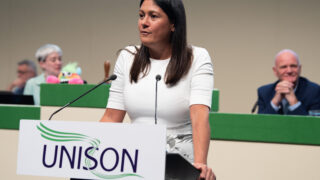UNISON recently launched Bringing Services Home, a national campaign aimed at bringing currently outsourced vital public services back in-house.
The union believes that the high-quality public services that everyone needs are best delivered directly by our public sector employers, ensuring that private companies are not running them for profit.
UNISON’s bargaining support group has created a detailed guide outlining the key phases of an insourcing campaign and providing helpful resources for anyone thinking about running one. This includes model surveys, case studies, planning template checklists, key arguments and key targets.
Below is the condensed five-phase plan, explaining how to win insourcing.
Phase 1 – Research and campaign development
Phase 1 in any campaign usually involves asking a lot of questions. The same is true of an insourcing campaign. Ignore the understandable urge to jump straight in. It’s vital that you lay strong foundations by identifying the scope of the campaign, what you want to win and how you’re going to win it.
Key areas and questions will be:
What is your target – which outsourced service, or services, do you want to insource? This may seem obvious, but you need to go deeper and find out:
-
- What contracts are outsourced? Which companies run them? Why were they outsourced? When did they start? When do they end?
- How many people are employed on these contracts? What jobs do they do? What are their terms and conditions? What are the demographics?
Who at the public authority/commissioning body ultimately makes the decision to insource? Once you know that, ask yourself:
-
- What are their motivations?
- How can we exert influence over them?
- Who are our potential allies in this campaign?
What workplace issues can be highlighted in the campaign – and how can insourcing provide a solution to them. For example:
-
- Are there people doing similar jobs on different terms & conditions or pay?
- Would insourcing help with equal pay issues?
- Would insourcing be cheaper for the public authority, and/or provide a better service?
Another key aspect of the campaign should be how it can benefit the collective strength of the union. You should record baseline levels of membership and activism among the outsourced staff. Then identify how the campaign can grow membership and increase participation.
Once you have answers to all of these questions, you should collate the information and finalise a target for your campaign that is winnable within the available time and resources.
From there, establish a campaign team, or organising committee, and develop a timeline and resourced plan. The team should include active and respected leaders from the workforce, as well as branch officers and regional staff. And for your plan to work it must be developed in a way that actively requires member participation if it is to succeed.
Phase 2 – Build your base
With a strong basis of information and a clear strategy, the next phase becomes more practical. The campaign hasn’t launched yet, but you have a good idea of its scope and, in this phase, you are looking to put yourself in as strong a position as possible to launch the campaign.
Begin to develop relationships with potential community and political allies. Start to organise in the workplace before the campaign begins, to increase membership and activism and to identify and confirm issues to organise around. Having a strong and organised membership, with reps and activists, is vital to sustaining and winning your campaign.
By the end of this phase, you should have finalised your ‘plan to win’ – a clear strategy to build power and exert enough influence over the decision maker to move them to insource.
Phase 3 – Launch your insourcing campaign
By the time you launch the campaign, you should be in a position of strength. It is absolutely vital that the ‘plan to win’ has the confidence of the membership, because, as mentioned in phase 1, it requires their participation – this will inspire a sense of ownership and responsibility among them, which will turn the launch into a springboard for recruitment and increased activism.
Members must also understand that winning insourcing campaigns requires significant public-facing activity to leverage the decision makers.
Phase 4 – Escalate, and create crisis (for the decision maker)
After the launch, begin to escalate the campaign. Actions should start relatively ‘soft’, providing opportunities for members to participate and demonstrate strength of feeling, with things like workplace petitions.
Then move to more open displays, such as badge days, building towards ‘harder’ actions – collective activities like meetings or rallies.
Ultimately, the campaign may escalate to a formal ballot for industrial action, which should only be undertaken with advice to ensure a lawful dispute.
Success relies on incremental escalation, which helps test the temperature of members while building their participation and resolve, as well as gradually increasing pressure on the decision maker.
Bring pressure on the decision maker from a number of directions, to ‘create a crisis’ where the cost to them of continuing the dispute exceeds any costs of insourcing, whether this be financial, political or ideological.
Phase 5 – Win, celebrate, review and sustain
Once the crisis point is reached and (hopefully) a commitment to insource is won, it’s important not to rest on your laurels. Often the web of privatisation can be difficult to unpick. Even with commitments to insource, there will be any number of issues specific to your workplace which will arise within the transfer back in-house.
This could be making sure staff are banded correctly before the transfer or conducting risk assessments and agreeing new health and safety policies. All this will require continued engagement with members and the employer.
Also, the increased levels of membership and activism are not guaranteed – sustaining them can often be more difficult than attaining them. Members may rightly be pleased and grateful that UNISON has helped win them insourcing, but some will ask: “What is UNISON doing for me now?” Take advantage of the momentum and continue organising, to try to create self-sustaining levels of membership and activity.
Once the process is completed, conduct a thorough review of the key lessons you have learnt, with recommendations to inform future UNISON organising strategy.
Finally, your success can inspire others, embolden the union as a whole, and pave the way for further such successes in the same workplace. So, make sure to promote it and celebrate it.
Access the full bargaining guide at: https://unsn.uk/3EEDQNC
Remember to stay in touch with UNISON – organisers can help to support your campaign and we’d love to hear about your successes. Contact: bringingserviceshome@unison.co.uk








A very useful guide. However, whilst this is clearly for use within the Union, things have a habit of ‘getting out’ and one thing that does not lend the Union a sympathetic light is aggressive terminology. I refer to the term ‘create a crisis’. If decision makers get wind of such material, it is likely to only encourage them to actively resist any campaign to in source services. Something more along the lines of ‘escalate and build greater momentum’ might be viewed as less confrontational.
Just a thought.